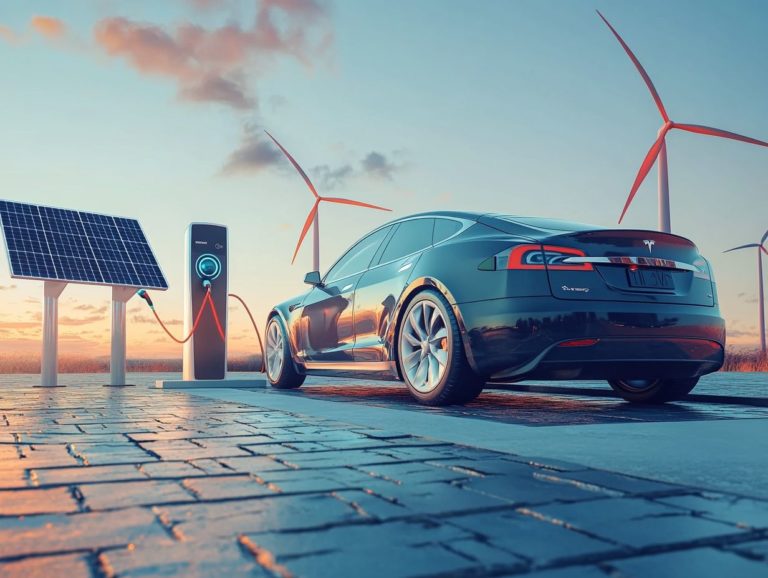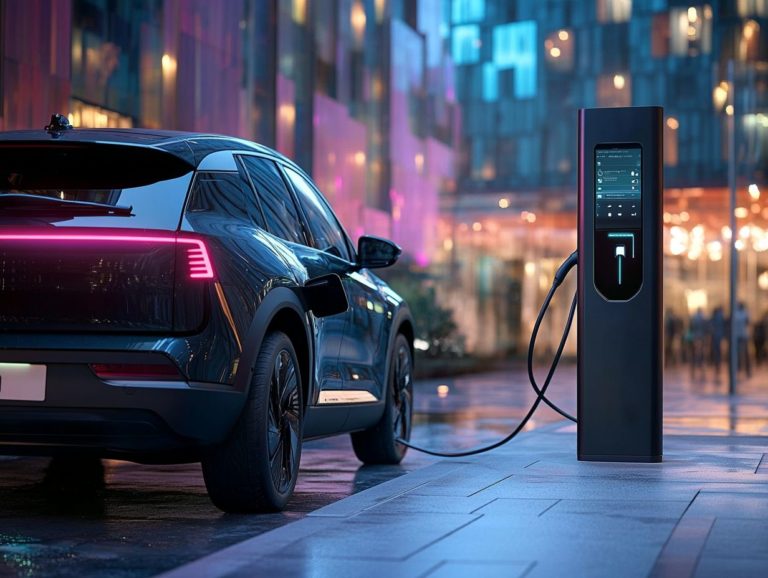how do electric vehicles work?
Electric vehicles (EVs) are transforming transportation by offering a cleaner and more efficient alternative to traditional gas-powered cars.
You ll delve into the key components of an electric vehicle, from the battery to the electric motor and controller. Let s dive into how these parts work together brilliantly, including innovative features like regenerative braking, which helps recharge the battery while slowing down.
You ll explore the advantages of EVs, such as their environmental benefits and cost savings. We ll also look ahead to the future of this rapidly evolving industry.
Prepare to uncover the mechanics and benefits of electric vehicles in a way that will enhance your understanding and appreciation of this groundbreaking technology!
Contents
Key Takeaways:
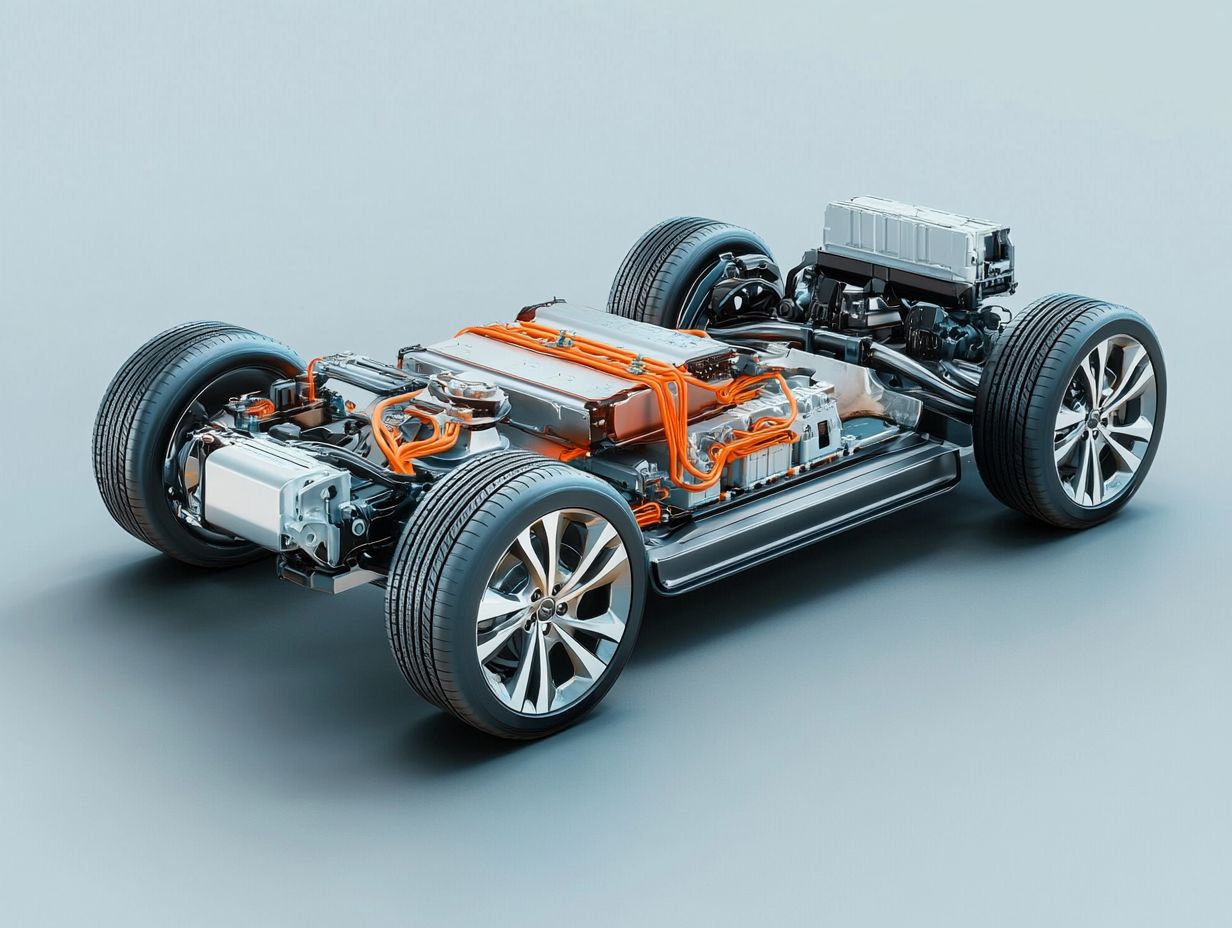
Electric vehicles are powered by an electric motor fueled by a battery.
The battery can be charged and discharged, providing energy to the motor that powers the vehicle.
Electric vehicles help the environment and can save you money.
They are driving advancements in technology and impacting the automotive industry.
What are Electric Vehicles?
Electric vehicles (EVs), especially battery electric vehicles (BEVs) and plug-in hybrid electric vehicles (PHEVs), mark a significant transformation in the automotive world. They offer a sustainable alternative to traditional internal combustion engine cars.
With growing global awareness of environmental issues, these vehicles are gaining recognition for promoting clean air initiatives while providing low maintenance and cost-effective choices.
BEVs run exclusively on electric energy powered entirely by batteries, producing no tailpipe emissions. PHEVs blend electric propulsion with gasoline engines, offering greater flexibility based on your travel needs.
Beyond their role in reducing harmful greenhouse gases, electric vehicles come with impressive low maintenance benefits due to having fewer moving parts compared to conventional vehicles. This translates to lower repair costs and enhanced longevity.
For eco-conscious drivers like you, EVs are an increasingly appealing option for efficient and cost-effective transportation.
Components of an Electric Vehicle
Electric vehicles consist of several essential components that work together to deliver an efficient and powerful driving experience.
These include the traction battery pack, electric traction motor, power electronics controller, and advanced thermal system. Each element contributes significantly to optimal performance, energy efficiency, and overall reliability.
Battery
The battery in your electric vehicle, particularly if it s a lithium-ion type, is the heart of the operation. It determines your vehicle’s range and performance due to its energy density and traction battery pack capabilities.
Lithium-ion batteries stand out with their remarkable energy density, allowing for a more efficient and compact power source. This directly enhances your acceleration and hill-climbing prowess, making every drive more exhilarating.
The configuration of traction battery packs is crucial, enabling the seamless transfer of power to the electric motors. This ensures optimal performance regardless of driving conditions. With ongoing innovations in battery chemistry and architecture, the way your vehicle operates is continually evolving, promising even greater efficiencies and longevity in the future.
Ready to explore how electric vehicles can change your life? Let’s go!
Electric Motor
The electric traction motor is truly the heart of your electric vehicle, often referred to as the electric car engine. It delivers rapid acceleration and a smooth operation that sets EV performance apart from traditional vehicles.
This groundbreaking component works by converting electrical energy from the battery into mechanical energy, which then powers the wheels. Unlike internal combustion engines that rely on a labyrinth of moving parts and fuel combustion, these motors operate with impressive simplicity and efficiency.
Electric traction motors shine when it comes to generating high torque from a standstill. This enables swift speed increases that elevate your driving experience.
You’ll find various types of electric motors, such as AC induction motors and permanent magnet synchronous motors, in different models. Each type offers unique advantages regarding performance and range.
This technological shift not only helps reduce emissions but also fosters quieter, smoother transportation.
Controller
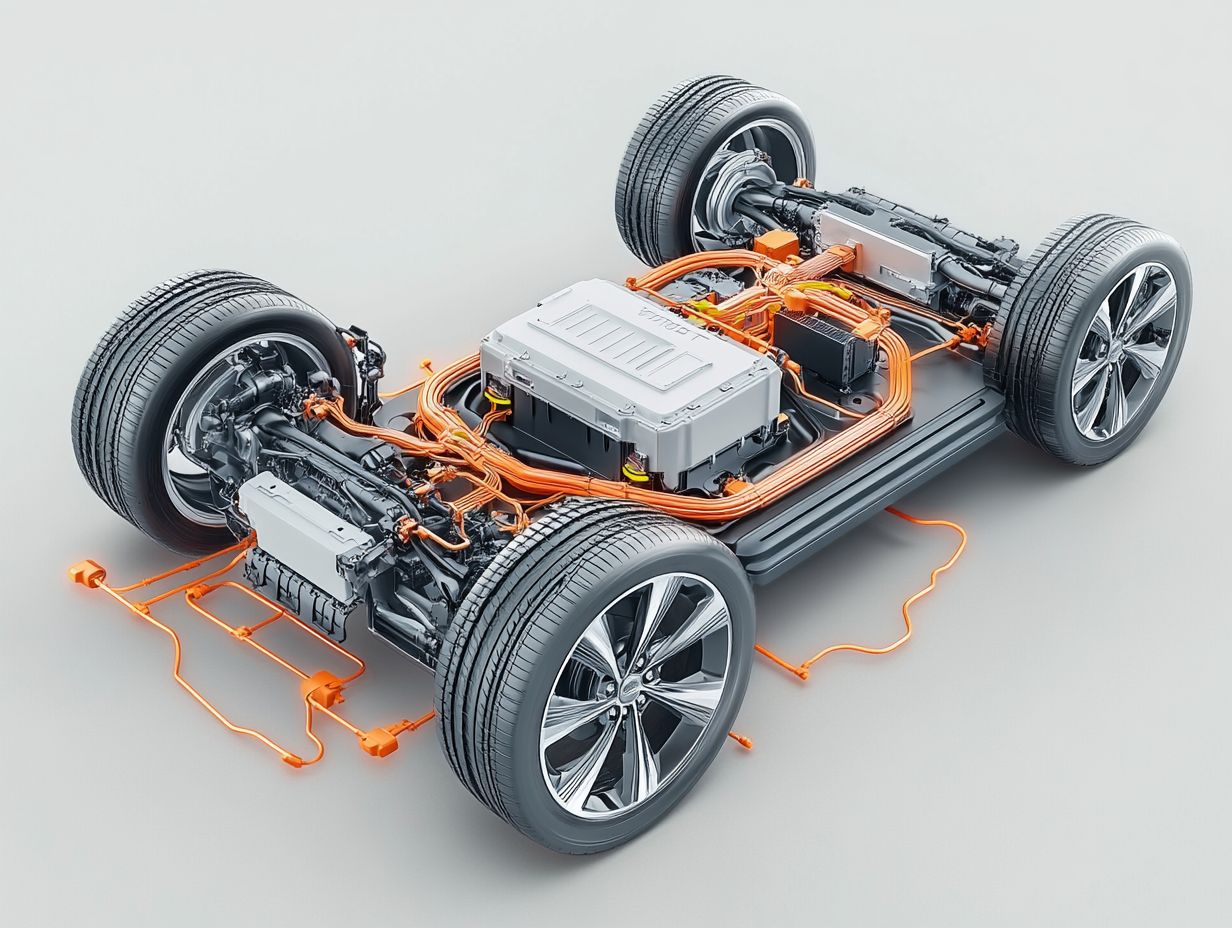
The controller serves as the brain of your electric vehicle. It expertly manages the flow of electricity between the battery, electric motor, and charging systems, ensuring efficient performance and a seamless driving experience.
This vital component optimizes energy distribution, enhancing your vehicle’s range, acceleration, and overall responsiveness. By working in tandem with inverters a device that changes direct current (DC) from the battery into alternating current (AC) for the motor the controller ensures maximum efficiency.
It also monitors battery chargers, balancing charge times while safeguarding battery health. Through these intricate interactions, the controller ensures that every joule of energy is utilized effectively, directly influencing your vehicle’s efficiency and driving satisfaction.
How Electric Vehicles Work
Electric vehicles function on a simple yet effective principle of charging and discharging. By utilizing electric vehicle supply equipment (EVSE) at charging stations, you can efficiently replenish the energy stored in the battery, keeping your vehicle running at its best.
Grasping this process is essential for enhancing your EV’s performance and maximizing its range.
Charging and Discharging the Battery
Charging and discharging the battery in electric vehicles is straightforward with tools like charging cables and various types of chargers. You’ll find level 1 and level 2 chargers at most charging stations.
These chargers differ in output, which directly impacts how swiftly your vehicle can replenish its energy supply. Level 1 chargers, often found at home, provide a slower charging option that’s perfect for overnight sessions.
On the other hand, level 2 chargers offer a more rapid energy boost, catering to those with tighter schedules. Charging cables also come in various lengths and designs, granting you the flexibility to meet your unique needs as a driver.
Ultimately, choosing the right charging solutions significantly enhances the convenience and efficiency of recharging your electric vehicle. This makes the switch to this eco-friendly alternative not just viable but truly appealing for everyday use.
Powering the Electric Motor
Powering the electric motor means converting the energy stored in your battery into mechanical energy through an inverter and a sophisticated power electronics system. This allows for precise control and smooth operation.
This transformation starts when the direct current (DC) from your battery flows into the inverter. The inverter expertly converts it into alternating current (AC) that the motor can utilize.
The power electronics are essential in this process, regulating voltage and current to guarantee that the motor receives just the right amount of power. This enhances efficiency and performance.
By modulating the frequency and shape of the AC output, these systems enable you to adjust speeds and torque as needed, adapting effortlessly to various driving conditions.
Together, these components create a seamless flow of energy, ensuring optimal performance and responsiveness that elevate your driving experience.
Regenerative Braking
Regenerative braking is a key feature of electric vehicles. It captures the movement energy generated during braking and converts it into electrical energy, which is stored in the battery for later use.
This advanced system boosts the efficiency of electric vehicles and reduces reliance on traditional braking methods, ultimately extending their lifespan.
By harnessing energy that would otherwise be wasted, you can enjoy a greater driving range and save energy, contributing to a more sustainable driving experience.
For instance, popular models like the Tesla Model 3 and the Nissan Leaf utilize this technology, allowing you to take longer journeys without frequent recharging.
As electric vehicles gain traction in urban areas, regenerative braking plays an essential role in clean air initiatives, helping to reduce emissions and create healthier communities.
Advantages of Electric Vehicles
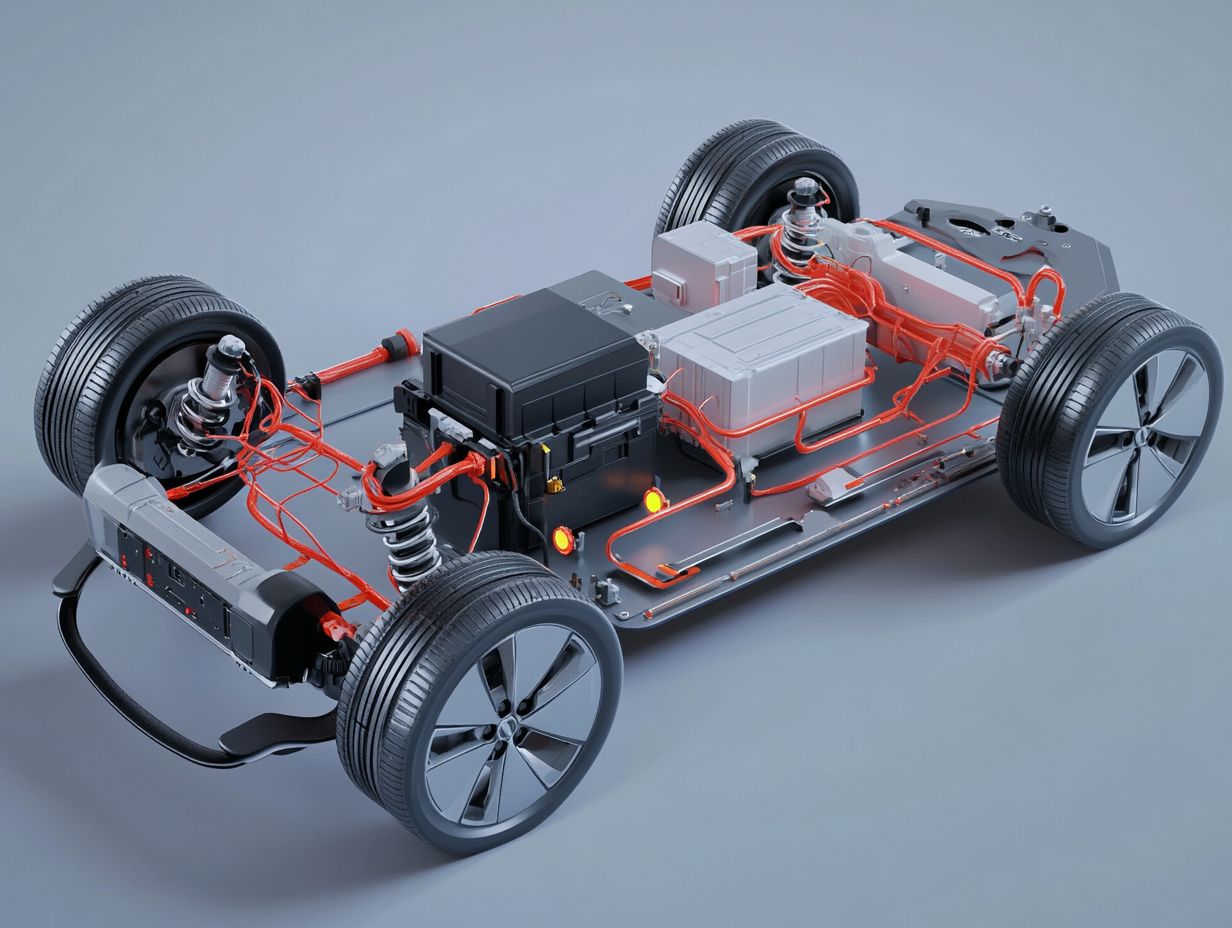
Electric vehicles are packed with exciting advantages. They significantly enhance air quality by lowering emissions, making them a great choice for environmentally conscious drivers.
Their low maintenance needs make them practical for many people. Plus, the thrill of fast acceleration adds an exhilarating twist to everyday driving.
In today s eco-friendly market, these features make electric vehicles incredibly appealing to discerning consumers.
Environmental Benefits
One major advantage of electric vehicles is their contribution to cleaner air. With zero tailpipe emissions, they can be powered by renewable energy sources, including hydrogen in some models.
Unlike traditional gasoline cars, which release harmful pollutants that harm air quality and contribute to climate change, electric vehicles operate with a cleaner energy profile. They can utilize solar, wind, and other renewable resources, significantly reducing their lifecycle emissions.
As the energy grid shifts toward greener options, the carbon footprint of charging these vehicles decreases even further.
This transition improves urban air quality and promotes energy independence by reducing reliance on fossil fuels. Essentially, electric vehicles are a vital step toward sustainable transportation, helping to create a cleaner environment for future generations.
Cost Savings
Electric vehicles offer significant cost savings by reducing maintenance needs and lowering fuel expenses compared to traditional gasoline vehicles.
These benefits become clear when you consider the reduced frequency of repairs and the elimination of oil changes, leading to substantial long-term savings. Charging an EV often costs less than gasoline, translating to noticeable fuel savings over time.
Government incentives or rebates can enhance the financial appeal, making the initial investment more manageable and potentially offering tax credits or lower registration fees.
Ultimately, owning an electric vehicle can be a savvy financial decision for many drivers.
Future of Electric Vehicles
The future of electric vehicles is on the verge of transformative advancements in technology. Innovations in battery technology and electric traction motors promise to elevate performance, efficiency, and sustainability in the automotive industry.
These developments are shaping a new era for eco-friendly driving.
Advancements in Technology
Recent advancements in battery technology are paving the way for more efficient electric vehicles. Innovations like increased energy storage and better thermal management systems mean longer ranges and faster charging capabilities.
These improvements not only enhance electric vehicle performance but also make them more appealing to consumers who value convenience and sustainability.
The integration of advanced power electronics has led to smarter energy management systems. This allows for improved energy conversion and extends battery lifespans.
The expansion of charging infrastructure, including ultra-fast stations and wireless charging options, addresses a major concern for electric vehicle owners: range anxiety. This makes the shift to clean mobility more accessible and practical for everyday drivers.
Impact on the Automotive Industry

The rise of electric vehicles is transforming the automotive industry. Manufacturers are compelled to innovate and adopt cleaner technologies, especially with initiatives like California’s Clean Vehicle Rebate Project.
This evolving landscape is reshaping vehicle design and production while influencing market trends and consumer preferences at an astonishing pace.
With governments prioritizing sustainability through stricter emissions regulations, automakers are focusing on developing electric powertrains and advanced battery technology.
Your desire to reduce your carbon footprint is driving a significant demand for eco-friendly alternatives. This interest is prompting manufacturers to rethink traditional supply chains and invest in advanced manufacturing processes to maintain a competitive edge.
Watch this video to understand how electric vehicles work in detail.
Frequently Asked Questions
How do electric vehicles work?
Electric vehicles use electricity stored in a battery to power an electric motor, which turns the wheels and moves the vehicle forward. If you’re curious about what an electric vehicle is, this is the basic concept.
What type of battery is used in electric vehicles?
Most electric vehicles use lithium-ion batteries. They are known for their high energy storage and long lifespan, although some older models may still use lead-acid batteries.
How do electric vehicles charge?
You can charge electric vehicles by plugging them into a charging station or a standard wall outlet. Additionally, the battery can charge while braking, a process known as regenerative braking.
How far can electric vehicles travel on a single charge?
The range depends on battery size, driving habits, and terrain. Most modern electric vehicles can travel about 200-300 miles on a single charge.
Do electric vehicles require regular maintenance?
Electric vehicles have fewer moving parts than traditional gas-powered cars, so they generally need less maintenance. However, it is still essential to regularly check the battery, tires, and brakes.
How do electric vehicles compare to gas-powered vehicles in terms of performance?
Electric vehicles are known for their instant torque, making them efficient and responsive. They also tend to have a lower center of gravity, providing better stability and agility on the road.



